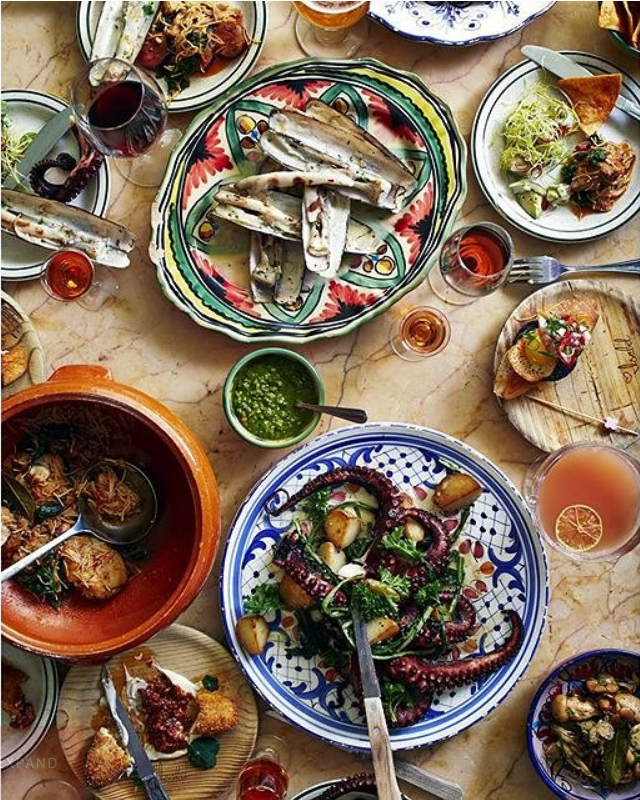Why Toronto Is Becoming the World’s Next Culinary Destination – Vogue
Toronto has been experiencing quite a boom: In 2015, the population of the greater Toronto area topped 6 million people for the first time, and it now boasts 91 high-rise buildings under construction—the most of any North American city besides New York. And for a city that has lived in the shadow of the “Canada’s New York” moniker for far too long, Toronto seemed to finally be getting excited about building its own name. But sheer numbers and growing skylines only count for so much. When it comes to identity, few things are able to define a geographical area and its people as well as its food.
Walk along a main street of a booming Toronto neighborhood and you’re almost guaranteed to get hungry, but first, you might get a bit confused about what you’re seeing (and smelling) around you. In Roncesvalles on the city’s West End, where La Cubana, a cozy Cuban diner, sits adjacent to Shala-Mar, a locally beloved Indian restaurant, you’ll also find Nine Restaurant and Tapas Bar serving up Korean brunch and tapas, a sprawl of pizzerias—most popular of which is the notoriously busy Pizzeria Defina—and a self-aware sign outside Barque, a perpetually bustling barbecue joint, advertising “Authentic Southern Ontario barbeque.” Turn the corner into Parkdale and you’re greeted with Brazilian at Mata; tacos at Grand Electric; a tiki bar as heavy on Pan-Asian influence as it is on boozy cocktails at Miss Thing’s; some of the best roti you’ve ever had at Mother India; and enough authentic Tibetan restaurants to make your heart sing. Go further into Kensington and Chinatown and you’ll find Rasta Pasta, a no-frills Jamaican jerk chicken and pasta stand; beef bourguignon and bo tai chanh on the same menu at Peoples Eatery; and Vietnamese banh mi sandwiches, Chinese pineapple coconut buns, and Jamaican beef patties all for $2 or less within a stone’s throw of each other at Nguyen Huong, Mashion Bakery, and Golden Patty, respectively.
The sheer diversity of Toronto’s food scene makes it somewhat daunting to navigate. Instead of boasting a unifying local style of cooking, the “local” cuisine is instead a compilation of borrowed garam masala, gochugaru, and jerk spice that have been made to coexist beside one another by the people living in the area, 47 percent of whom speak a mother tongue other than the country’s native English or French.
Because of this, there is a large-scale cultural synthesis at play in Toronto’s dining landscape. At the city’s best and most exciting restaurants like Bar Isabel, DaiLo, Boralia, and Alo, the manifestation of this melting pot is decidedly elegant and paired down: foie gras mousse and yuzu kosho at Alo; halloumi and black bean chili sauce at DaiLo; Chinese tea eggs and pine needle–smoked mussels at Boralia; jamón Iberico de Bellota, and shishito peppers at Bar Isabel. These creative menus illustrate what happens when so many cultures coexist—the unifying culinary tradition becomes diversity.
“One of the greatest examples I think there is of Toronto’s food is Foxley on Ossington Avenue,” says Chris Nuttall-Smith, The Globe and Mail’s dining critic. “You have a chef from Vietnam who moved here in the 1980s who learned to cook sushi, worked at Canoe [a critically acclaimed Toronto fine-dining institution], and dated a Jewish guy from uptown and learned to cook his mother’s brisket. I think, more than anything, Toronto’s food is a kind of synthesis—it pulls from all sorts of traditions around us and turns them into something that is uniquely Toronto.”
For a nation whose food identity is so deeply buried under Tim Hortons doughnuts and ketchup chips that many dismiss the idea of an authentic Canadian cuisine ever really existing, Toronto is the best-case scenario: The absence of tradition has allowed a creative, anything-goes climate to thrive. Because of this, there is huge culinary opportunity in Toronto, and many of the world’s biggest chefs have noticed, hauling their Michelin stars north and setting up shop.
One of the first big-name chefs to make the move was David Chang, who debuted a three-story Momofuku building in downtown Toronto in 2012. That success served as a green light for other celebrity chefs, and the floodgates were open. Michelin-starred chef Daniel Boulud opened the French-themed Café Boulud in the city’s Yorkville neighborhood; Jonathan Waxman opened the California-inspired Montecito; MasterChef Canada’s Alvin Leung opened R&D—his take on Chinese-Canadian dim sum; Jamie Oliver opened the first North American outpost of Jamie’s Italian; Mario Batali, Joe Bastianich, and Lidia Bastianich scoured the area for a potential Eataly location; and even celebrities, like Mark Wahlberg of Wahlburgers and Drake—whose Fring’s opening might have been seen as inevitable to some—came to Toronto to stake their claim to the city.
Yet while the new profusion of celebrity restaurants has helped elevate the city’s culinary reputation, they are far from the only exciting dining experiences happening within Toronto’s borders. When it comes to tasting Toronto’s most delicious flavors, a mix of modern fine dining, eclectic street food, and possible celebrity run-ins is the only combination sure to do the trick.


Leave a Reply